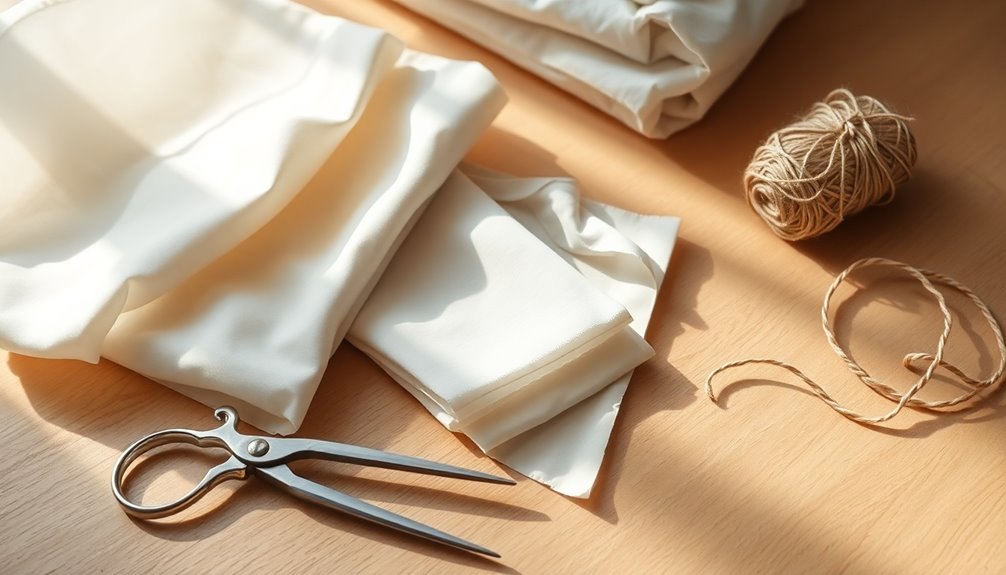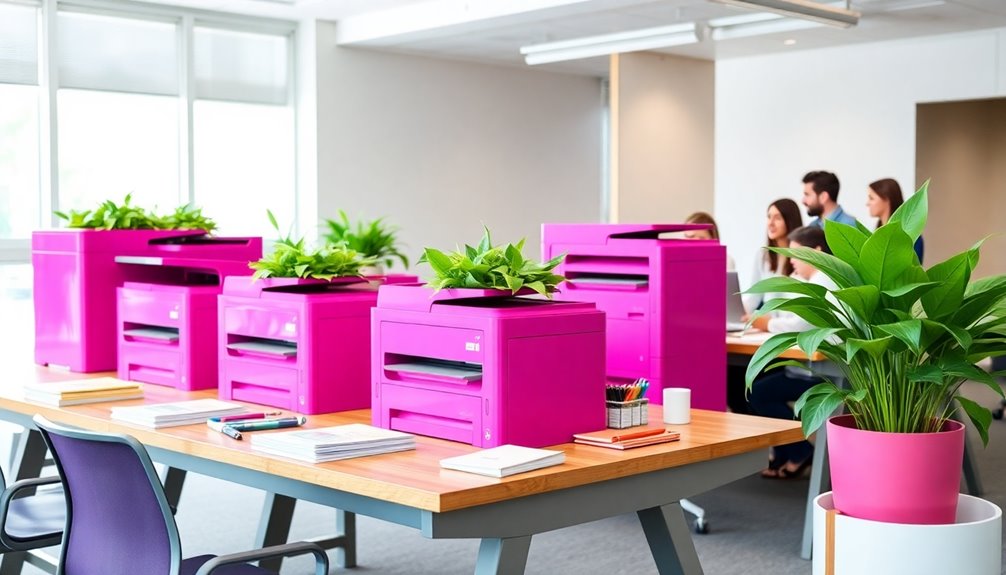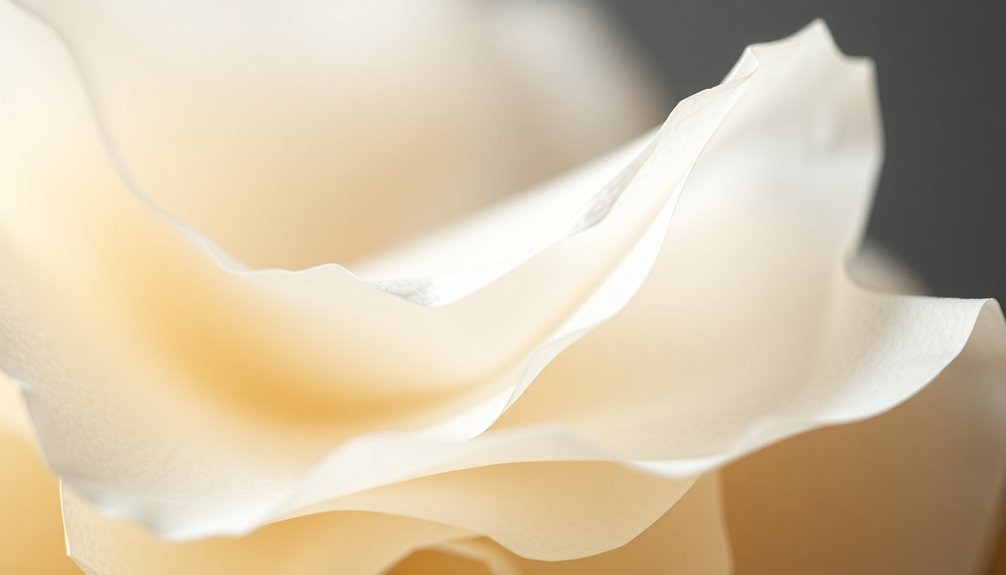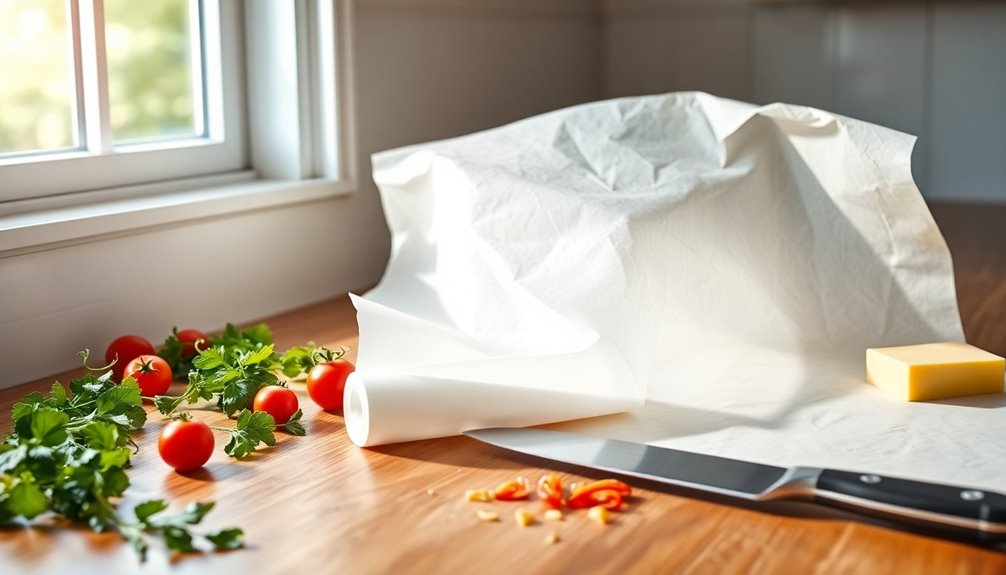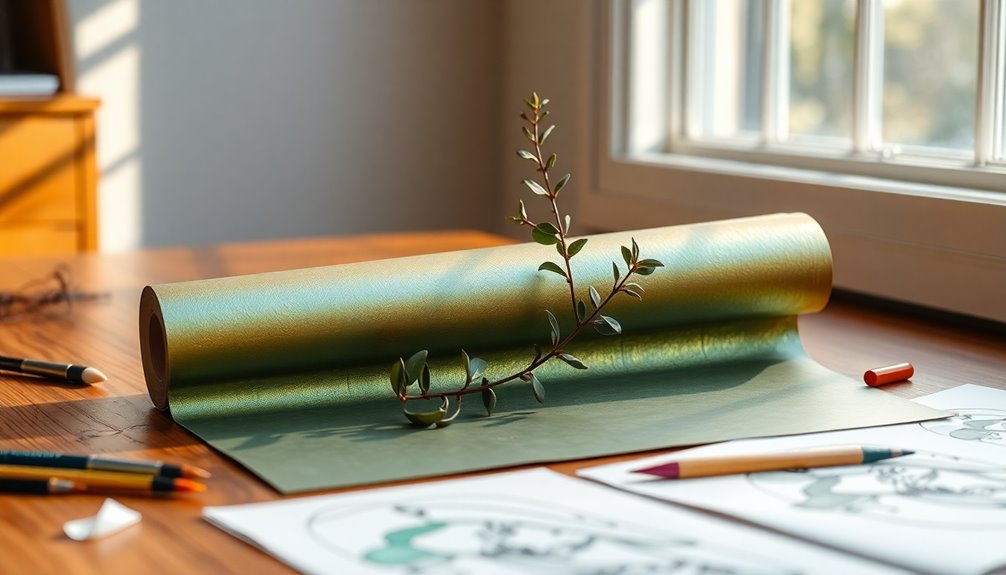To wrap clothes for storage, you should use acid-free tissue paper to protect your garments. Start by laying sheets between them to prevent color transfer. Fold the clothes along natural seams and stuff delicate areas with tissue to maintain their shape. Wrap each item fully to avoid creasing. Line storage boxes with more acid-free tissue to add extra protection. Avoid using cardboard, as it can stress the fabric. Store in a cool, dry, and dark environment to further preserve quality. There are many more tips and techniques to guarantee your clothes remain in excellent condition.
Key Takeaways
- Use acid-free tissue paper to prevent color transfer and protect delicate fabrics while wrapping.
- Carefully fold garments along natural seams and stuff them with tissue to maintain shape.
- Fully wrap each garment with acid-free tissue to avoid creasing and protect from dust.
- Line storage boxes with acid-free tissue for added protection and to minimize moisture retention.
- Store garments in a cool, dry, and dark environment to prevent fabric degradation over time.
Benefits of Acid-Free Tissue Paper
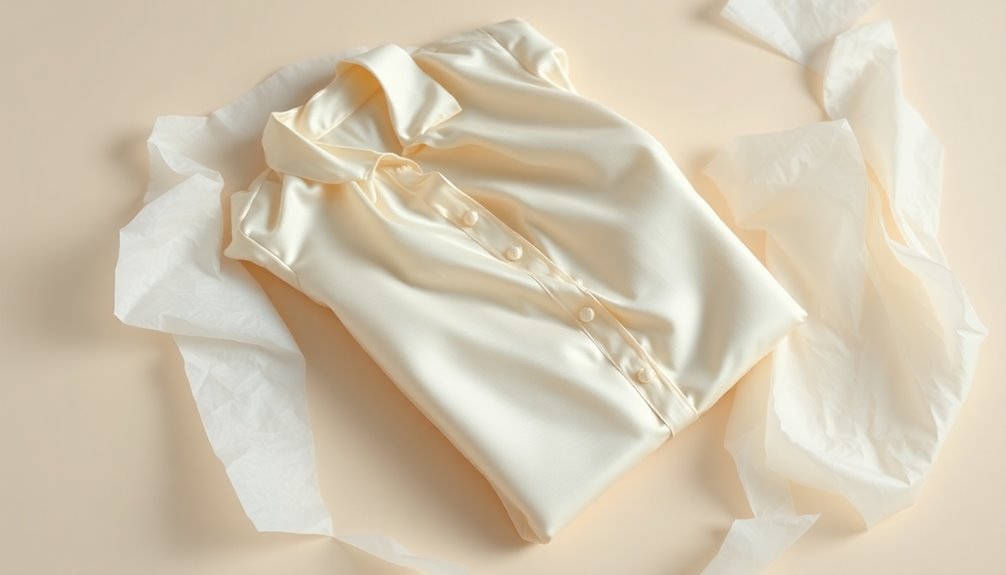
When it comes to storing your clothes, using acid-free tissue paper can make all the difference. Unlike regular tissue paper, which can deteriorate and potentially damage your garments over time, acid-free tissue paper is pH neutral. This quality prevents dye transfer and harmful reactions with delicate fabrics, ensuring that your cherished items, like christening gowns, stay in pristine condition.
One of the standout benefits of acid-free tissue paper is its ability to maintain the integrity of delicate or vintage fabrics. It's specially processed to remove contaminants, offering an extra layer of protection during storage.
Additionally, acid-free tissue paper provides essential breathability for your clothing, reducing moisture retention that could lead to mildew and mold over time.
Essential Wrapping Techniques
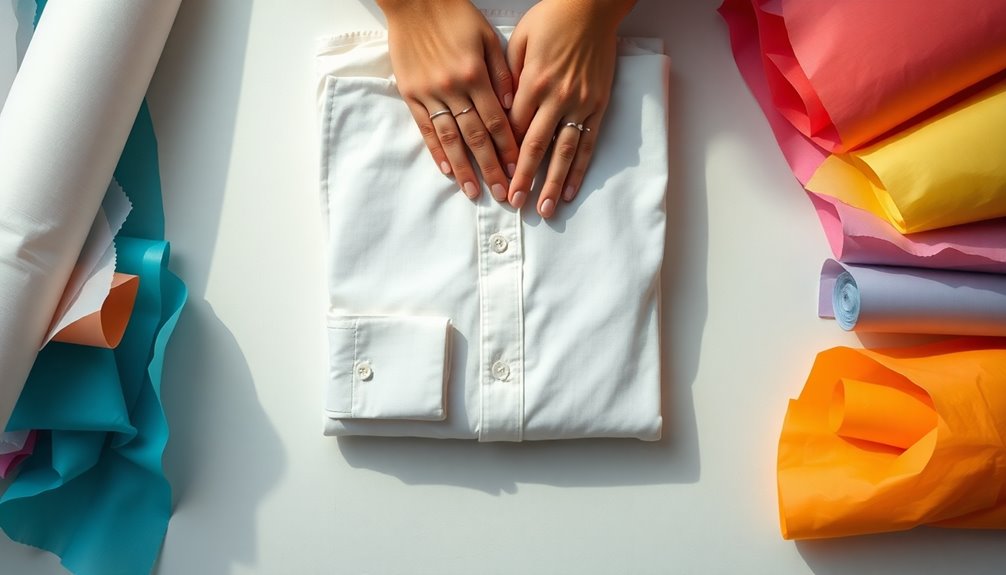
Properly wrapping your clothes for storage is essential to keeping them in excellent condition. To achieve this, follow these essential wrapping techniques:
- Use acid-free tissue paper: Lay out sufficient sheets to separate each garment, preventing color transfer between multi-colored items.
- Fold with care: Carefully fold garments along their natural seams. Use layers of acid-free tissue paper to cushion delicate areas, minimizing creases.
- Wrap completely: Wrap each garment fully in acid-free tissue, stuffing areas like sleeves and bodies to maintain shape and avoid flat creasing.
Before you place wrapped garments into archival boxes, line them with large sheets of acid-free tissue paper. This provides extra protection and prevents direct contact with the container.
Additionally, make sure to incorporate moth repellent sachets within the storage box to enhance protection against pest damage during long-term storage.
Acid-Free vs. Regular Tissue Paper
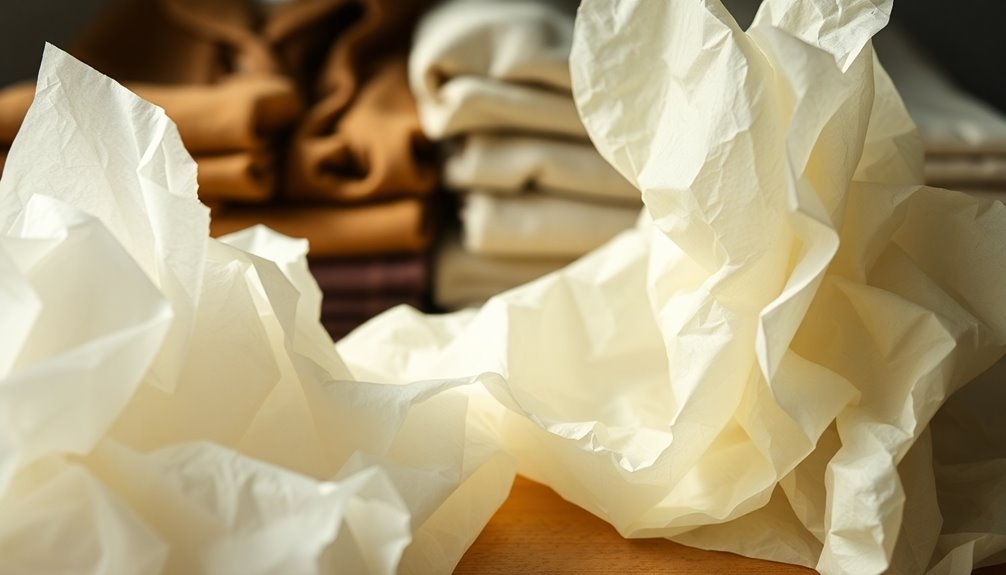
Choosing the right type of tissue paper for wrapping your clothes can greatly impact their preservation during storage. Acid-free tissue paper is specifically processed to be pH neutral, avoiding harmful reactions with your fabrics.
In contrast, regular tissue paper often contains dyes that can damage textiles over time. This deterioration can lead to yellowing or weakening of your valuable garments.
When you use acid-free tissue paper, you're protecting the integrity and appearance of delicate items. It also provides breathability, reducing moisture retention and preventing mold and mildew development, which isn't guaranteed with regular tissue paper.
Not all tissue paper is acid-free, so it's important to check product labels before making a purchase.
Using acid-free tissue paper in combination with proper storage techniques is vital for preserving fine clothing. This guarantees their longevity and shields them from environmental damage.
Ultimately, investing in acid-free options is a smart choice for anyone serious about protecting their wardrobe during long-term storage. By making this small change, you'll help maintain the quality of your clothes for years to come.
Where to Buy Acid-Free Tissue
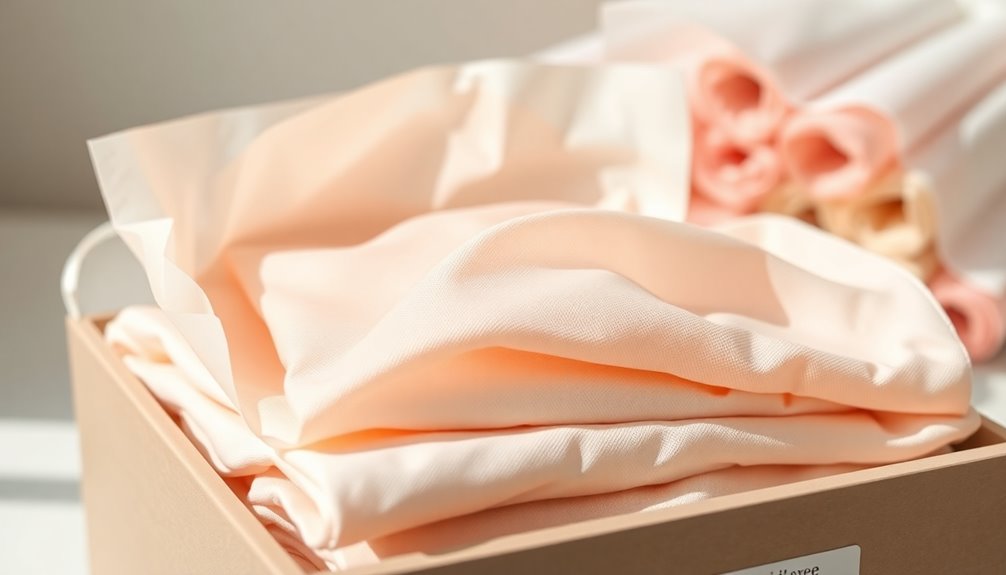
When you're looking for acid-free tissue paper, local craft stores are a great starting point, offering a variety of options.
You can also explore online retailers for convenience and wider selections, often featuring customer reviews to help you decide.
If you need larger quantities, specialty packaging suppliers usually have bulk options that cater to extensive storage needs.
Local Craft Stores
Local craft stores are a treasure trove for anyone looking to buy acid-free tissue paper for wrapping clothes. These stores often carry a variety of options, guaranteeing you find the perfect fit for your delicate garments.
You'll love the ability to choose from different sizes and colors, allowing for a personal touch in your storage solutions.
When you visit, keep an eye out for these important items:
- Bulk Acid-Free Tissue Paper: Ideal for larger storage projects, saving you both time and money.
- Customizable Options: Choose colors that complement your wardrobe or reflect your style, making the storage process enjoyable.
- Additional Archival Materials: Don't forget to check for acid-free boxes and other storage solutions that enhance your garment preservation efforts.
Before purchasing, always check the product labels to confirm the tissue paper is acid-free. Not all tissue paper is suitable for protecting your fabrics, so this step is essential.
Online Retail Options
Shopping for acid-free tissue paper online opens up a world of convenience and variety. You can find options at numerous online platforms, from craft stores to specialty boutiques. It's crucial to choose a retailer that offers eco-friendly choices to guarantee you're not only protecting your garments but also being kind to the environment.
When you're browsing, look for bulk purchasing options, which can save you money whether you're a business or just storing multiple items. Always check product labels to confirm that the tissue is truly acid-free and free from harmful dyes that could damage your fabrics.
Here's a quick comparison of where you might find acid-free tissue paper online:
| Retailer Type | Product Range | Eco-Friendly Options |
|---|---|---|
| Craft Stores | General acid-free tissue paper | Often available |
| Art Supply Retailers | Specialized archival-grade options | Frequently offered |
| Specialty Boutiques | Unique and varied selections | Usually available |
Specialty Packaging Suppliers
For those seeking high-quality acid-free tissue paper, specialty packaging suppliers are an excellent resource. They focus on providing archival materials that protect your clothes while in storage.
You'll find a variety of options to suit your specific needs, whether you're wrapping delicate fabrics or storing cherished heirlooms.
Here are three reasons to evaluate specialty packaging suppliers for your acid-free tissue needs:
- Quality Assurance: You can trust that the tissue paper is free from harmful dyes and chemicals, ensuring your fabrics remain safe and undamaged.
- Eco-Friendly Choices: Many suppliers offer sustainable options, allowing you to store your items while being kind to the environment.
- Bulk Purchasing: Buying in bulk often means cost savings, especially if you're storing numerous items or planning for future projects.
When shopping, always check product labels to confirm their acid-free status.
With specialty packaging suppliers, you'll find the perfect materials to keep your treasured garments in pristine condition, giving you peace of mind that they'll be preserved for years to come.
Moth Prevention Strategies

Since moths are notorious for damaging stored clothes, implementing effective prevention strategies is essential. Start by regularly cleaning your garments before storage. This eliminates food stains and odors that attract moths, ensuring a clean surface for protection.
Next, consider using natural moth repellents like cedar blocks or lavender sachets within your storage containers. These can effectively deter moths and other pests.
It's also important to avoid overcrowding your wardrobes or storage bins. Allowing fabrics to breathe reduces moisture retention, which can lead to infestations. Instead of folding, think about rolling your garments. This minimizes creasing and stress on the fabric, making them less appealing to moths looking for weak areas.
Additionally, make it a habit to check and refold your stored clothing every few months. This helps maintain fabric condition and allows you to detect any early signs of moth activity.
Preparing Garments for Storage
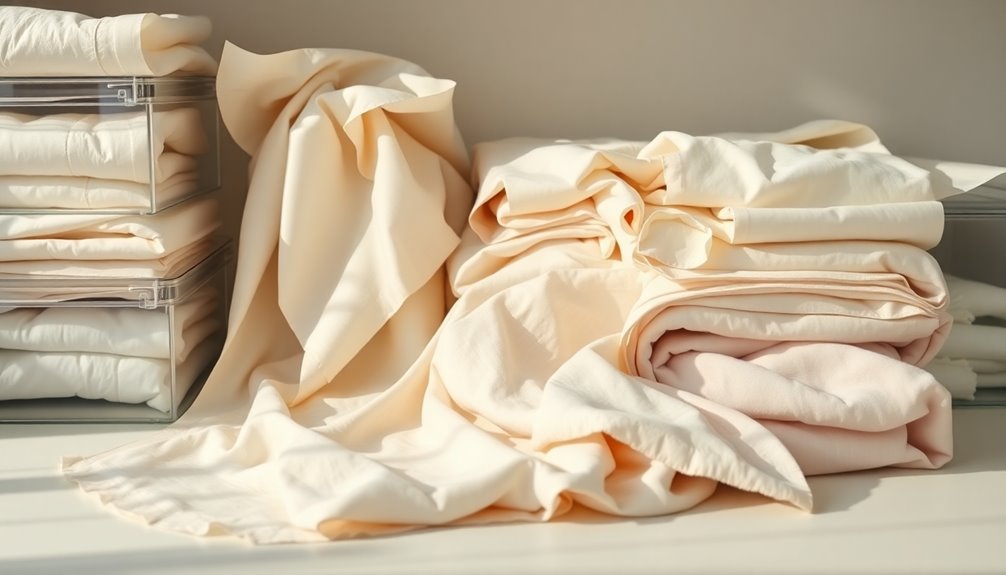
Before you store your clothes, make sure to clean them thoroughly to remove any stains that could cause damage over time.
Once they're fresh, stuff them with acid-free tissue paper to help maintain their shape and prevent creasing.
Wrapping the garments completely in tissue will protect them from air exposure and keep them in great condition.
Clean Before Storage
Preparing your clothes for storage starts with a thorough cleaning. You want to eliminate any food stains and odors that can lead to fiber deterioration over time.
Here are three vital steps to guarantee your garments are ready for their long-term rest:
- Professional Cleaning: Always take your garments to a professional dry cleaner or launder them at home. This step is essential for removing any stubborn stains that could cause permanent damage.
- Inspect for Stains: Pay special attention to any visible stains. If they're left untreated, they can worsen and compromise the fabric's integrity.
- Dry Completely: Make sure your garments are completely dry before wrapping them up. Moisture can lead to mold and mildew, ruining your clothes while they're stored away. Additionally, proper cleaning techniques can help ensure that your garments remain in good condition during storage.
Use Acid-Free Tissue
Proper preservation of your garments hinges on using acid-free tissue paper during storage. Before you wrap your clothes, make certain they're clean and free from stains; untreated stains can lead to fiber deterioration over time.
Once your garments are ready, stuff the arms and body with acid-free tissue to maintain their shape and prevent creasing.
It's essential to wrap each piece completely in layers of acid-free tissue to minimize exposure to air, which helps reduce the risk of moisture retention. When folding your garments, do so along natural seams and include layers of tissue between folded pieces to prevent abrasion and color transfer. This method guarantees that your clothing remains in pristine condition while stored.
Avoid using cardboard inserts or supports, as these can place stress on the fabric. Instead, rely on acid-free tissue for gentle support during storage.
This simple step will greatly extend the life of your garments, allowing them to stay fresh and ready for future use. By following these guidelines, you'll protect your clothes effectively, ensuring they remain a cherished part of your wardrobe for years to come.
Specific Tips for Wedding Attire
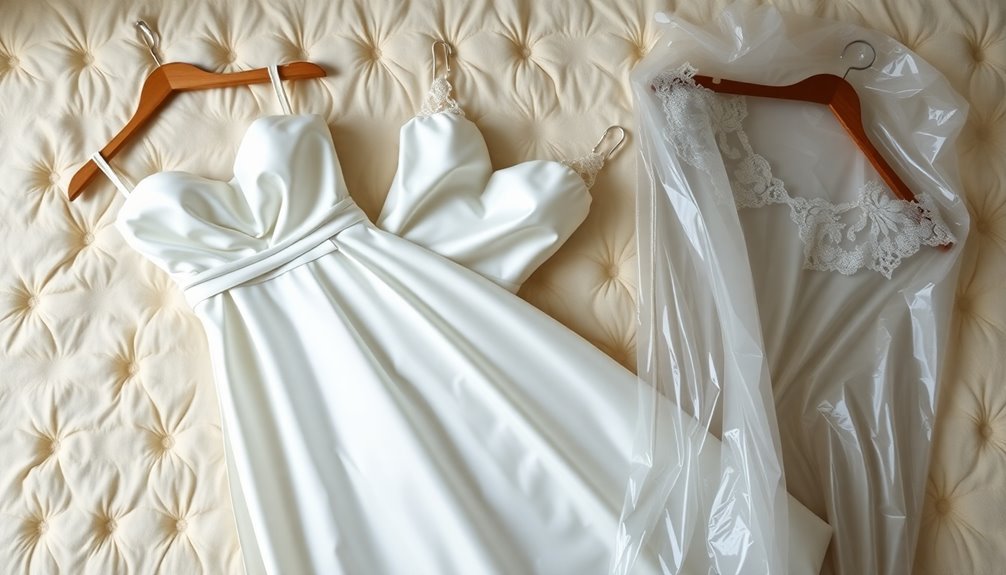
When it comes to storing your wedding attire, taking the right precautions guarantees your gown remains pristine for years to come.
Start by separating your veil from the gown. This prevents fabric snags and damage that can occur from contact. Next, avoid placing shoes and crinolines inside the gown's storage. This minimizes pressure and potential wear on your beautiful dress.
To make certain your gown stays in perfect condition, follow these essential tips:
- Use acid-free tissue paper: Place it between layers of the folded gown to provide cushioning and prevent creasing.
- Keep items spaced apart: Maintain adequate spacing between different fabric items to avoid abrasion and preserve the gown's integrity.
- Check for materials: Ensure that any plastic, wire, or trim doesn't touch the fabric directly, as this can lead to reactions and staining.
General Storage Practices

Effective storage practices are vital for preserving the longevity of your clothing and textiles. Start by folding items like tablecloths and quilts with layers of acid-free tissue paper in between. This prevents creasing and abrasion during storage. Always store your textiles in a cool, dry, and dark environment to protect against degradation caused by light, heat, and moisture.
Regularly checking your stored items for signs of damage or deterioration is important. This proactive approach guarantees they remain in peak condition over time. For valuable textiles, consider using climate-controlled storage to maintain consistent temperature and humidity levels.
Lastly, document your storage conditions and dates. This practice helps you track the preservation status of your garments and facilitates future assessments.
| Storage Practice | Importance | Emotional Impact |
|---|---|---|
| Use acid-free tissue paper | Prevents damage | Peace of mind |
| Cool, dry, dark environment | Protects against degradation | Confidence in preservation |
| Regular checks | Guarantees peak condition | Connection to cherished items |
Environmental Considerations
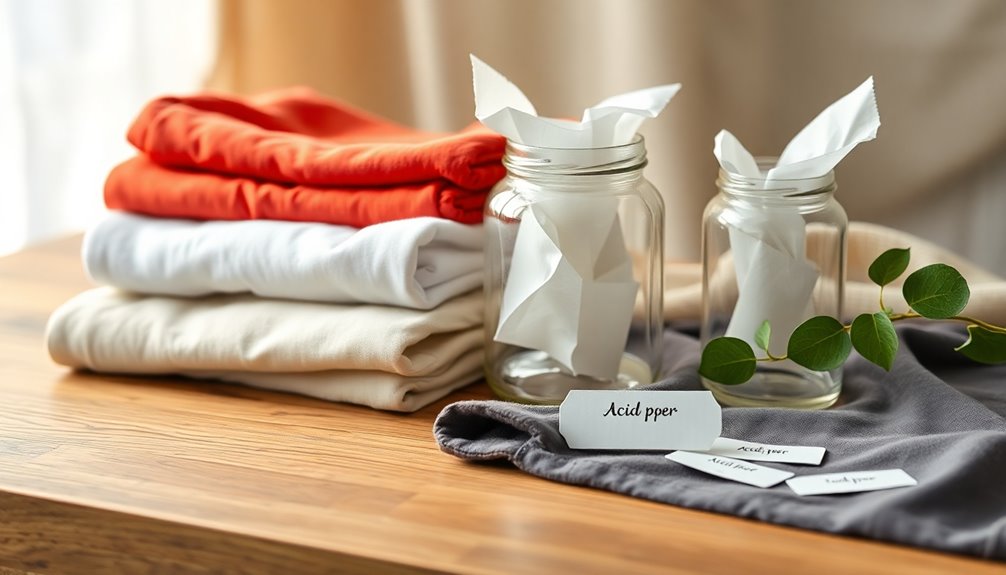
To protect your stored clothes, maintaining a stable environment is essential. Ideally, you should keep the temperature around 65-70°F and the humidity between 40-50%. This helps prevent degradation of the fabrics.
Avoid exposing your garments to direct sunlight or artificial light; UV rays can cause fading and weaken fibers over time.
Regularly check your storage area for any signs of moisture, mold, or pests. Damp environments can lead to mold growth, which can ruin your favorite pieces. High heat can also be damaging, causing yellowing or brittleness in fabrics.
Here are three key environmental considerations to keep your clothes safe:
- Temperature Control: Keep it cool and steady.
- Light Protection: Shield your fabrics from UV rays.
- Moisture Management: Regularly inspect for dampness or pests.
Additionally, consider practicing eco-friendly practices to further protect your garments while contributing to a sustainable lifestyle.
Frequently Asked Questions
How Do You Protect Clothes in Long-Term Storage?
To protect clothes in long-term storage, start by cleaning them thoroughly to remove stains and odors.
Wrap each garment in acid-free tissue paper to prevent color transfer and protect delicate fabrics.
Use acid-free archival boxes to store the wrapped clothes, ensuring they're shielded from harmful acids.
Incorporate breathable fabric covers for added dust and moisture protection, while allowing airflow.
Finally, check on your stored items regularly to maintain their condition and shape.
How to Properly Archive Clothes?
To properly archive clothes, start by cleaning them thoroughly to remove any stains or odors.
Use acid-free tissue paper to stuff and wrap each garment, helping them maintain shape and preventing creases.
Store your items in solid, acid-free archival boxes, layering them with tissue paper to avoid color transfer.
Regularly check on your stored clothes for any signs of damage, and rewrap them as needed to guarantee they stay in great condition over time.
How Do You Keep Clothes Fresh in Storage Boxes?
To keep your clothes fresh in storage boxes, use natural moth repellents like cedar or lavender sachets.
Layer acid-free tissue paper between garments to absorb moisture and prevent odors, creasing, and color transfer.
Regularly check for dampness and replace desiccants to maintain a dry environment.
Store your boxes in a cool, dark place, and consider breathable storage bags made of cotton or linen to protect against dust while allowing air circulation.
How Do You Store Clothes When Not in Use?
When you store clothes you're not using, start by cleaning them to prevent stains.
Fold each garment neatly and consider using acid-free tissue paper to maintain their shape.
Place them in breathable containers, avoiding plastic that traps moisture.
Keep your storage area cool, dry, and dark to protect against fading and mold.
Regularly check on your clothes to catch any signs of damage early, ensuring they stay in great condition.
Conclusion
In summary, wrapping clothes for storage with acid-free materials is essential for preserving their quality. By using acid-free tissue paper and following proper techniques, you can protect your garments from damage. Don't forget to implement moth prevention strategies and prepare your items carefully, especially delicate pieces like wedding attire. With these practices in mind, you'll guarantee your clothing remains in excellent condition for years to come. Happy storing!

